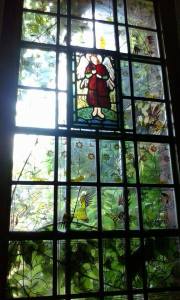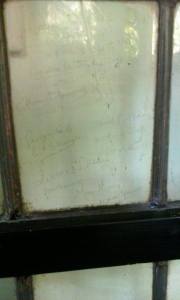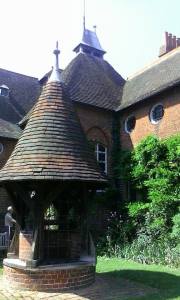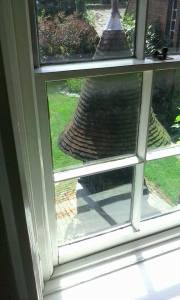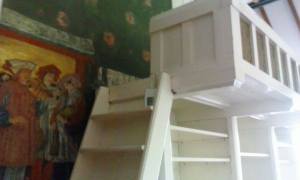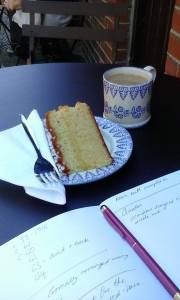Research at Red House: the Arts and Crafts

With sunlight flooding in from the garden through the open windows and picking out the gold detail in the Burne-Jones wall paintings, I definitely couldn’t have chosen a better day for my research trip to Red House in Bexleyheath, London (definitely worth the early start to catch the train from Leamington!). My visit to Red House was an opportunity to do some research for our upcoming Arts and Crafts House exhibition at Compton Verney in 2015, which will feature both historic works from key practitioners of the Movement as well as contemporary commissions.
The Red House is now owned by the National Trust – an extraordinary Arts and Crafts house conceived, created and enjoyed by William Morris and his bohemian family and friends. The house includes design features and furniture by William Morris and Philip Webb, and stained glass and paintings by Edward Burne-Jones – all key practitioners of the Arts and Crafts Movement. Red House was only acquired by the National Trust ten years ago (celebrating their 10th birthday this year just like Compton Verney!) – and it is this that makes the property so fascinating…
As I went round on my guided tour, I got the impression that William Morris and his artist friends had strove to decorate and make their mark on every single surface available to them – from chair backs and insides of cupboards, to the inscriptions of the names of visitors on the glass panes of the screen in the Garden Passage, as well as Burne-Jones’ elaborate wall paintings. The extraordinary thing is however that previous owners had covered up a lot of this decoration which has since remained hidden until these last ten years – with new discoveries being made all the time. For example, a biblical wall painting was revealed in the last few years – thought to be by Elizabeth Siddal with contributions from other artists – which had been covered with wallpaper and hidden behind a wardrobe in the master bedroom. It is a similar story in every room, with Morris designs and tantalising fragments of painting peeping through the wallpaper ready to be discovered. The conservators here certainly have a long job ahead of them!
A particularly interesting piece in the house was the glass screen in the Garden Passage which has been etched with the name of visitors to Red House – a kind of huge visitors book! May Morris’ signature, the daughter of William Morris, can be found on there among others.
The garden was also beautiful – designed to ‘clothe the house’. The lawn on the west side of the house is exactly as Morris would have intended it – the suburban garden ahead of its time with the lawn with its peripheral flower beds being very different to the Victorian tendency for fuss and flamboyance.
I was particularly excited to see the well, designed by Philip Webb and which Morris would have looked down upon from his studio and drawn his inspiration for the Strawberry Thief design among others. Our tour guide even pointed out Morris’ strawberry plant which features in his Strawberry Thief designs!
What struck me most of all about this beautiful house is the combination of practicality, minute details and artful design. Every last element has been thought through, from things like matching handles and window brackets to the settle in the dining room, which simultaneously displays brilliant design yet also could be used as a ladder to reach the storage space in the roof.
Finally, after I had exhausted the knowledgeable guides with all of my questions, I allowed myself a welcome piece of cake for lunch in the garden to write up my notes from the day.
The Arts and Crafts House will be Compton Verney’s Summer exhibition in 2015 – so watch this space for more updates!
Lucy
Programming Officer


